

Hotline:0755-22277778
Tel:0755-22277778
Mobile:13826586185(Mr.Duan)
Fax:0755-22277776
E-mail:duanlian@xianjinyuan.cn
The development momentum of high-speed trains is very strong. In 2021, the annual penetration rate of electric vehicles has exceeded 12%, nearly doubling from last year. From this trend, it can be seen that electric vehicles will develop even faster in the future. From the current state of development of electric vehicle technology, longer range and faster charging speed are still unsatisfactory. In order to achieve the above two important goals, it means that batteries with higher energy density and power density are needed, and these characteristics will release more heat from the battery. This heat can reduce the performance and lifespan of various components, and in severe cases, it may cause short circuits in the power lines, leading to spontaneous combustion of the vehicle.
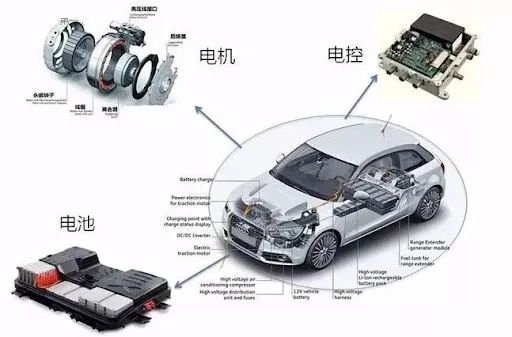
Core "Three Electrics" of Electric Vehicles: Battery Module, Electronic Control System, and Drive Motor
Therefore, in order to ensure the safety performance and service life of the core components of electric vehicles, such as the "three electric" and charging piles, we need to release heat in a timely and effective manner. This is where thermal management materials come into play, and thermal interface materials (TIM) play a crucial role in thermal management and are an important research branch in this discipline. The definition of thermal interface material is an intermediate material or component that can quickly transfer heat from the component that generates the heat source to the heat dissipation. Common types of thermal interface materials include:Thermal pad, silicon free thermal conductive gasket, thermal conductive gel - one component, thermal conductive gel - two components, thermal conductive gel - silicon freeTHERMAL GREASEThermal phase change materials, thermal sealing adhesives, thermal graphite sheets, etc.

Why do we need thermal interface materials?

For any thermal management solution, thermal interface materials (TIM) are a critical component. Due to being a small part of most applications, it is easy to overlook, but thermal interface materials can enable devices and their related products to function effectively. Thermal Interface Materials (TIMs) are critical components in numerous electronic and energy storage devices. Basically, if heat is generated and needs to be transferred, TIM is usually required.

The deep blue color in the above figure represents the thermal interface material, the light blue color represents air, and the gray and black colors represent two different surfaces. Any surface will have roughness, so when two surfaces come into contact, they cannot be completely in contact. There will always be some air gaps mixed in, and the thermal conductivity of air is very small (the thermal conductivity of air at 20 ℃ is 0.0267W/(m.K)), resulting in a relatively large contact thermal resistance. And using soft and plastic thermal interface materials can fill this air gap (of course, in most cases, it is almost impossible to completely eliminate air, so there will still be small air pockets in small depressions and holes. However, the thermal performance at this time has been greatly improved compared to the situation without using TIM), which can reduce contact thermal resistance and improve heat dissipation performance.
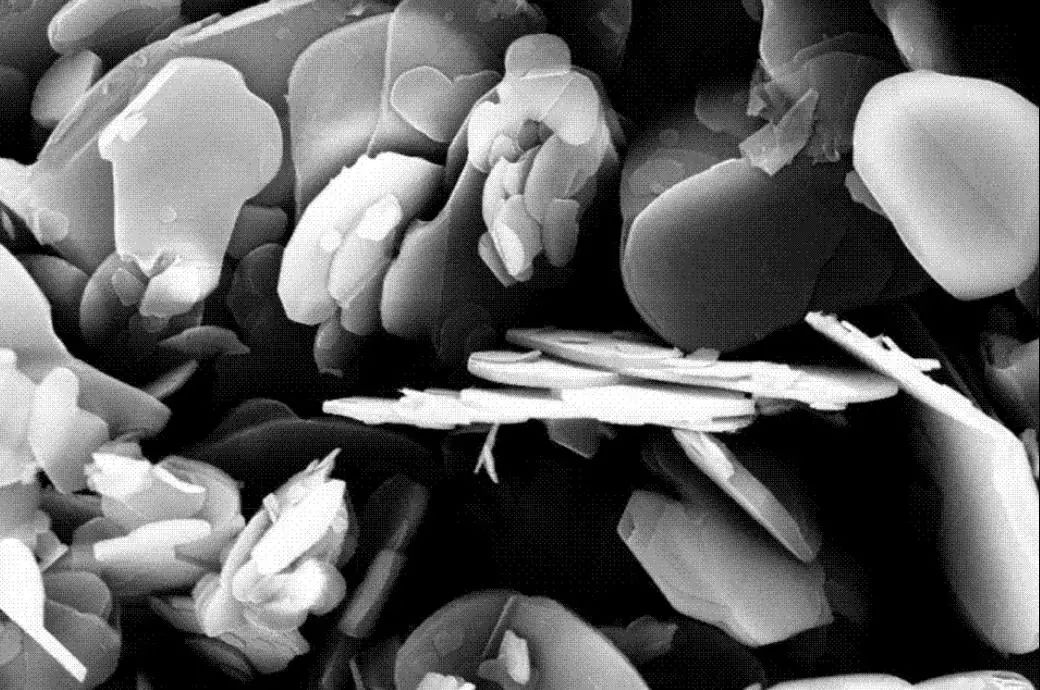
Hexagonal boron nitride sheet with thermal conductivity and non-conductive properties
Universal thermal interface materials are mostly based on resin and supplemented with thermal fillers as needed. Resin matrix materials are prone to deformation, which can effectively bridge gaps and increase effective contact to improve heat dissipation. However, resin matrix materials generally have poor thermal conductivity and need to be filled with thermal conductive fillers to effectively adjust their thermal conductivity and meet usage requirements.
The types of fillers can be divided into three categories, namelyMetal thermal conductive fillerCarbon based thermal conductive filler, inorganic thermal conductive filler. Common metal thermal conductive fillers mainly include Al, Cu, Ag, etc. Carbon based thermal conductive fillers mainly include graphite, graphene, carbon nanotubes, carbon fibers, etc. Inorganic thermal conductive fillers mainly include boron nitride (BN), silicon carbide (SiC), aluminum nitride (AlN), etc.
Thermal conductivity of common resin matrices and thermal conductive fillers
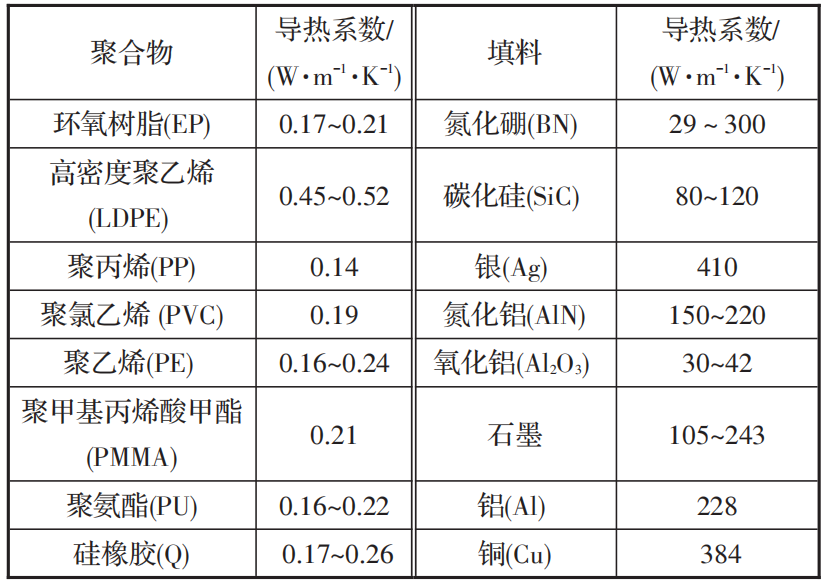
Inside the battery packThermal interface material:
Poor heat dissipation of batteries can reduce their charging rate, increase charging time, and even damage temperature sensitive batteries. The thermal design of the power lithium battery pack for electric vehicles is a key technology to ensure the reliable operation of the battery, and how to dissipate the heat from the battery cells is the core design consideration factor. The common cooling methods in battery thermal management are air cooling and liquid cooling, both of which first transfer heat from the battery system to the cooling pipes through heat conduction, and then transfer the heat to the air through the cooling pipes. In order to achieve the best heat dissipation effect of the cooling pipe, it is necessary to fill a high thermal conductivity interface material between the cooling pipe and the battery, thereby eliminating air, reducing heat transfer resistance, and significantly improving the heat dissipation effect.
Of course, in addition to thermal interface materials, the application of thermal conductive structural adhesives for electric vehicle battery packs is also quite extensive. Using them to replace traditional mechanical fasteners, screws, and rivets is beneficial for reducing the weight of the entire vehicle. According to publicly available data, battery packs can achieve a weight reduction effect of up to 30 kilograms, indirectly improving the vehicle's endurance. In addition, these adhesives also help significantly reduce the number of components required for automobiles and optimize the cost of battery pack design.
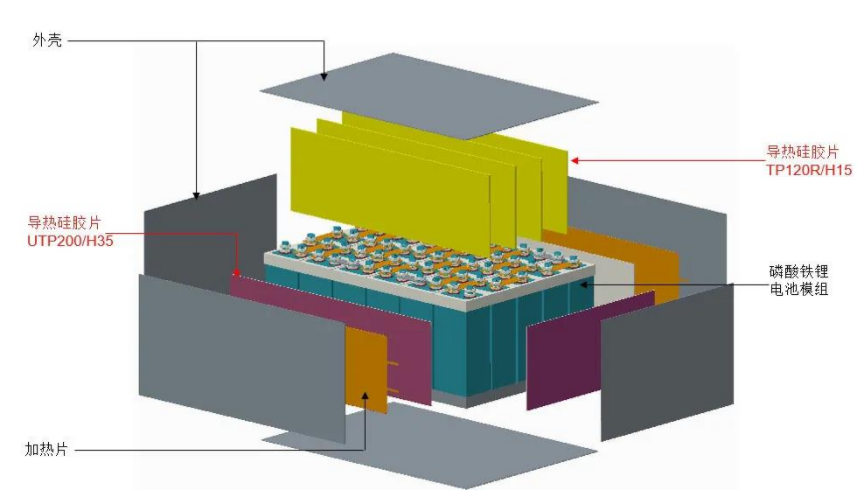
Structure of lithium iron phosphate hard shell battery pack
According to statistics, the weight of the battery panel in a household new energy vehicle is about 150-400kg, and the amount of silicone thermal conductive sealant used is about 20-50kg. The commonly used silicone sealant uses aluminum oxide, silicon micro powder, etc. as thermal conductive fillers. The specific gravity of the sealant is usually between 1.8-2.2g/cm3, the thermal conductivity is 0.4-0.8W/m * K, the flame retardancy reaches UL94V-0 or V-1, and it has good flowability.
Thermal interface materials in electric vehicle control systems:
In the field of new energy vehicles, IGBT, as the core component of the electronic control system and DC charging pile, directly affects the power release speed, acceleration ability, and maximum speed of electric vehicles, and its importance is self-evident. In general, IGBT modules need to withstand currents of several hundred amperes and switch thousands of times per second, resulting in significant losses. And it is located in the enclosed front compartment of the car with the motor, engine, etc., where the heat is relatively concentrated. IGBT is not afraid of short circuits, but it is particularly sensitive to heat. If the temperature exceeds its junction temperature of 125 ℃, it will cause the module to burn out and affect the operation of the entire vehicle. Temperature characteristics are important indicators in the design and reliability evaluation of IGBT module products. In order to significantly improve their power density, heat dissipation performance, and long-term reliability, an efficient heat dissipation scheme is particularly important.

Schematic diagram of IGBT motor water cooling
The commonly used heat dissipation methods for motor controllers currently include conduction heat dissipation and indirect water cooling. Its main feature is that a water channel needs to be designed on the metal shell, and the water flow does not have any contact with the IGBT. The heat emitted by IGBT needs to be transferred to the cooling water on the outside of the shell through the metal plate at its lower part, relying on conduction to dissipate the heat. To reduce the thermal resistance of the heat source and water circuit, and improve the thermal conductivity efficiency of the module, it is usually necessary to apply thermal grease to the rigid interface between the IGBT module and the cold plate. I have itThermal interface materialThe filling of (thermal conductive silicone grease, etc.) will fully contact the contact surface between the heat source and the heat sink, which can significantly reduce the interface thermal resistance, significantly improve the heat dissipation effect, and reduce electrical losses.
Thermal interface material in the drive motor:
An electric motor is a device that converts electrical energy into mechanical energy. It uses energized coils (i.e. stator windings) to generate a rotating magnetic field and applies it to the rotor (such as a squirrel cage closed aluminum frame) to form a magnetic electric rotational torque. It is obvious that the most important components in a motor are the stator and rotor. The stator is the stationary part of the motor, which consists of three parts: the stator core, the stator winding, and the frame. The main function of the stator is to generate a rotating magnetic field, while the main function of the rotor is to be cut by magnetic field lines in the rotating magnetic field and generate output current.
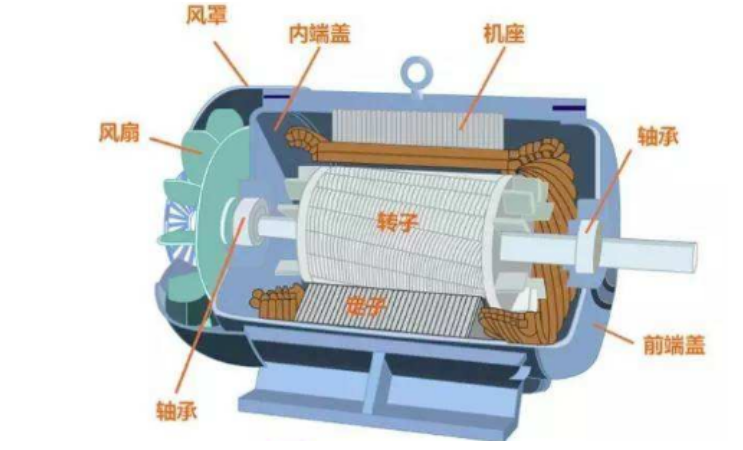
useHigh thermal conductivity adhesiveThe overall sealing of the motor stator can reduce the thermal resistance between the winding and the stator core, improve the thermal conductivity of the insulation system, and reduce the temperature rise of the motor by about 10-18 ℃, thereby improving the reliability of safe operation of the motor.
In addition, after the high thermal conductivity adhesive is filled into the stator of the drive motor, it can not only better help the drive motor dissipate heat, but also have excellent electrical insulation performance and electromagnetic compatibility to resist high voltage and electromagnetic interference; The stator is wrapped in encapsulated gel, which can also resist the erosion of atmospheric environments such as water vapor and salt spray, and to a certain extent, can effectively resist vibration and impact forces.
Thermal interface material in charging station:
The electric vehicle market is very lively, and of course, it is also necessary to pay attention to the heat dissipation problem of charging piles that supply energy to electric vehicles.
Compared with compact slow charging piles, high-power charging piles not only have high requirements for batteries and cables, but also have extremely high requirements for the cooling system of the charging pile: ① the faster the charging speed, the greater the power of the charging pile's inductance module, and the greater the charging current; ② Due to the high compression of the volume, the internal structure is very compact, and the heat is more concentrated, which leads to an increase in the internal temperature of the charging station. In mild cases, the over temperature protection of the charging module will no longer output, and in severe cases, it may cause accidents such as fires; Therefore, it is crucial to develop a proper heat dissipation plan for the charging station.
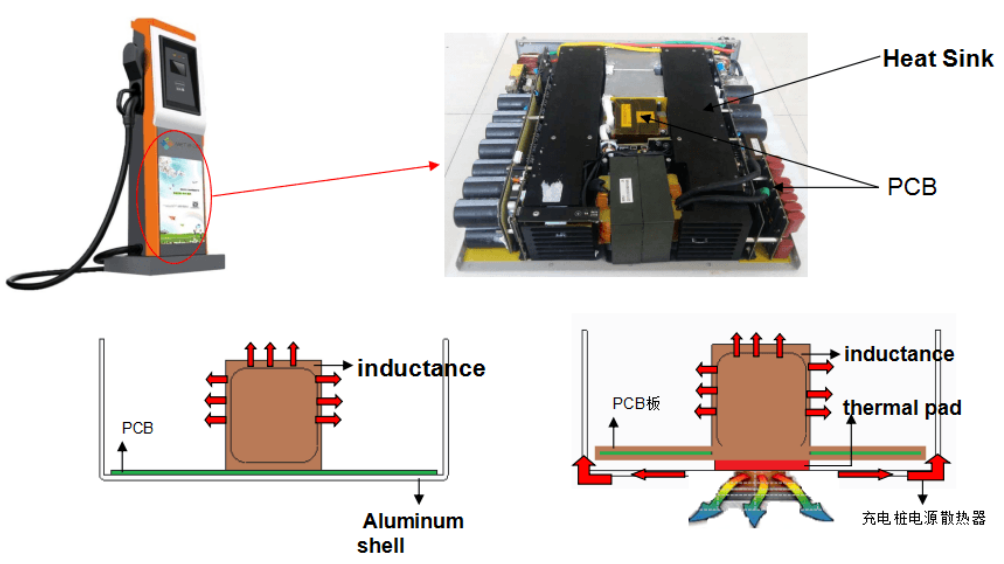
Thermal dispersion structure of charging station
The charging station module integrates a large number of high heat generating electronic components such as capacitors, inductors, MOSFETs, transformers, etc., and requires a built-in heat sink to assist in the heat dissipation of electronic components. At present, the introduction of high thermal conductivity interface materials is very common in the heat dissipation design of charging stations in the industry. For example, thermal conductivity silicone gaskets are used for thermal conductivity of inductance modules, thermal conductivity silicone grease is used for chip thermal conductivity, thermal conductivity silicone is used for power supply sealing, etc. Thermal conductivity silicone sheets and thermal conductivity adhesive are applied between integrated electronic component boards and heat sinks. The characteristics of softness and high rebound enable them to cover uneven surfaces and conduct heat from separation devices or PCBs to the heat sink, thereby improving the heat dissipation efficiency and service life of charging modules. At the same time, they also play important roles in thermal conductivity, insulation protection, shock absorption, and fixing electronic components, making the use of charging stations safer.

Advanced Institute (Shenzhen) Technology Co., Ltd, © two thousand and twenty-onewww.avanzado.cn. All rights reservedGuangdong ICP No. 2021051947-1 © two thousand and twenty-onewww.xianjinyuan.cn. All rights reservedGuangdong ICP No. 2021051947-2